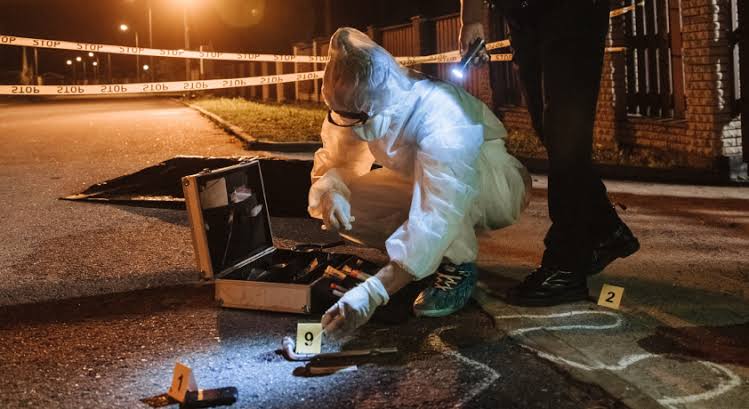INTRODUCTION The 21st century has accompanied in a new era of crime scene investigation (CSI). Gone are the days of relying solely on fingerprints and blood spatter analysis. Today, investigators have a vast arsenal of cutting-edge tools and techniques at their disposal, making it possible to solve crimes that were once considered cold cases. As technology continues to advance at an unprecedented pace, forensic experts and law enforcement agencies are embracing innovative approaches to unravel mysteries and solve crimes more efficiently. This article explores the new approach to crime scene investigation in the 21st century, highlighting the key advancements that have reshaped the field. TRADITIONAL CSI METHODS Traditional crime scene investigation methods involve a meticulous and systematic approach to gathering evidence and analyzing evidence at a crime scene, preserving the scene, and piecing together the events that transpired. While modern technology has revolutionized forensic science, many traditional methods remain fundamental to the investigative process. Here is an overview of some traditional CSI methods: 1. Securing and documenting the Scene: The first step is to secure the crime scene to preserve evidence and ensure the safety of investigators and others. This involves establishing a perimeter, restricting access, and controlling the scene. a. Initial response: Upon arriving at the scene, the first officers prioritize securing the perimeter, preventing contamination, and establishing a chain of custody for any evidence. b. Scene assessment: A thorough assessment of the scene is conducted, noting the location of the victim, potential witnesses, and any obvious signs of struggle or disturbance. c. Documentation: Detailed notes, photographs, and sketches are used to document the scene from various angles, preserving the initial state for later analysis. 2. Evidence collection: Investigators systematically search for and collect physical evidence, such as weapons, clothing, fingerprints, blood, hair, or any other items that may be relevant to the case. Each item is carefully documented, labeled, and packaged to maintain its integrity. a. Search patterns: Different search patterns are employed depending on the size and complexity of the scene. Common methods include strip searches, grid searches, and spiral searches. b. Identifying and collecting evidence: Trained personnel meticulously identify and collect various types of evidence, such as fingerprints, footprints, hair, fibers, blood, bodily fluids, weapons, and any objects that may be out of place. c. Proper packaging and labeling: Each piece of evidence is carefully packaged and labeled to maintain its integrity and chain of custody throughout the investigation. 3. Scene reconstruction and analysis: a. Analyzing evidence: Collected evidence is analyzed in forensic laboratories using various techniques, such as DNA analysis, fingerprint identification, ballistics testing, and toxicology tests. b. Reconstruction of events: Based on the evidence collected and analyzed, investigators attempt to reconstruct the sequence of events that transpired at the scene. This may involve witness interviews, timeline creation, and analysis of alibis. c. Case presentation: The findings of the investigation are presented to prosecutors and used to build a case against the suspect(s). 4. Additional traditional methods: a. Fingerprinting: One of the oldest and most reliable methods of identifying individuals at the scene. b. Bloodstain pattern analysis: Analyzing the shape and distribution of bloodstains can provide clues about the movements and positions of individuals involved. c. Trace evidence analysis: Minute particles like hair, fibers, and paint chips can link suspects to the scene or victim. d. Entomological evidence: Studying insects found on the body or at the scene can help determine the time of death or the location of the body. While technology has undoubtedly transformed forensic science, traditional methods remain crucial for gathering essential evidence, preserving the integrity of the scene, and piecing together the puzzle of what happened. These methods, when employed effectively, can help bring perpetrators to justice and provide closure to victims and their families. NEW CSI TECHNOLOGIES In recent years, there has been an explosion of new CSI technologies that are revolutionizing the way we investigate crimes. Some of the most promising new technologies include: 1. 3D crime scene mapping: This technology allows investigators to create a precise 3D model of the crime scene, which can be used to analyze evidence and reconstruct the events of the crime. 2. Drone forensics: Drones are increasingly being used to survey crime scenes, collect evidence, and take aerial photographs. 3. DNA phenotyping: This new technology allows investigators to predict the physical characteristics of a suspect based on their DNA. 4. Digital Forensics and Cybercrime Investigation: In the digital age, crimes are not confined to physical spaces alone. Cybercrime has become a prevalent threat, necessitating a paradigm shift in crime scene investigation. Digital forensics plays a pivotal role in uncovering evidence from electronic devices, social media platforms, and online activities. Investigators now employ sophisticated tools to analyze digital evidence, trace the origins of cyber-attacks, and establish connections between virtual and physical crime scenes. 5. Big Data Analytics: The sheer volume of data generated in the modern world can be overwhelming, but it also presents an invaluable resource for investigators. Big data analytics enable law enforcement agencies to sift through massive datasets to identify patterns, trends, and correlations. This approach can aid in predicting criminal behavior, tracking suspects, and solving complex cases by leveraging the power of data analysis. 6. Remote Sensing Technologies: The 21st century has witnessed the integration of remote sensing technologies into crime scene investigation. Unmanned aerial vehicles (UAVs) equipped with high-resolution cameras and sensors can capture detailed images of crime scenes from various perspectives. This not only aids in documenting the scene more comprehensively but also facilitates the identification of potential evidence that might be overlooked from ground-level observations. 7. Artificial Intelligence and Machine Learning: Artificial intelligence (AI) and machine learning (ML) algorithms are increasingly being employed to assist investigators in processing and analyzing vast amounts of data. These technologies can help identify patterns in criminal behavior, analyze surveillance footage, and even predict potential crime hotspots. AI-driven tools also play a role in facial recognition, aiding in the identification of suspects captured on security cameras. 8. Advancements in DNA Analysis: DNA analysis has been a game-changer in forensic science, and recent advancements have further enhanced its capabilities. Rapid DNA testing allows for quicker analysis of DNA samples, enabling investigators to obtain results within hours rather than days or weeks. Additionally, the expansion of DNA databases and the use of familial DNA searching have increased the likelihood of solving cold cases and identifying previously unknown suspects. 9. 3D Crime Scene Reconstruction: Traditional crime scene sketches are being replaced by three-dimensional (3D) reconstructions using cutting-edge technology. Laser scanners and photogrammetry techniques allow investigators to create detailed and accurate 3D models of crime scenes. This not only aids in preserving a virtual replica of the scene but also provides a valuable tool for courtroom presentations, helping judges and juries visualize the circumstances surrounding a crime. CONCLUSION The new approach to crime scene investigation in the 21st century is characterized by a fusion of traditional forensic techniques with state-of-the-art technologies. Digital forensics, big data analytics, advanced DNA analysis, remote sensing technologies, artificial intelligence, and 3D crime scene reconstruction have collectively revolutionized the field, empowering investigators to solve crimes more efficiently and accurately. As technology continues to evolve, it is crucial for law enforcement agencies and forensic experts to stay abreast of these advancements. Embracing the latest tools and methodologies ensures that investigators can navigate the complexities of modern crime scenes, ultimately contributing to a safer and more just society. The future of crime scene investigation holds the promise of even more groundbreaking innovations, further refining our ability to uncover the truth behind criminal activities.

